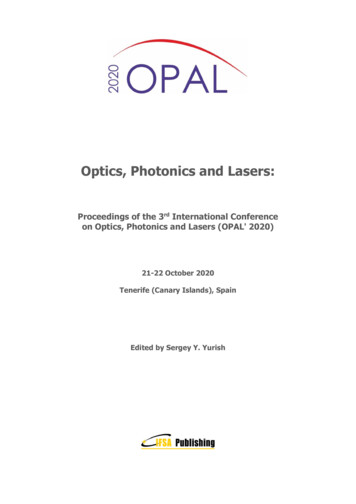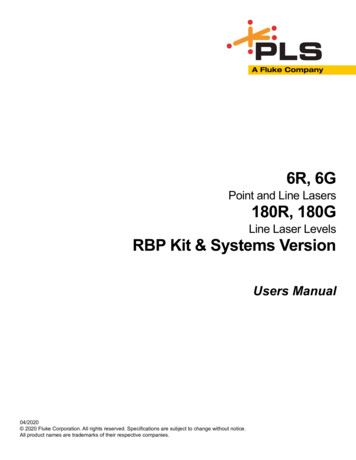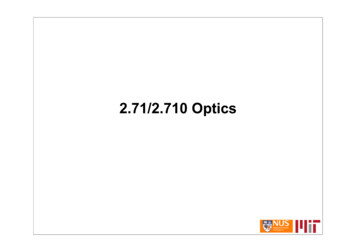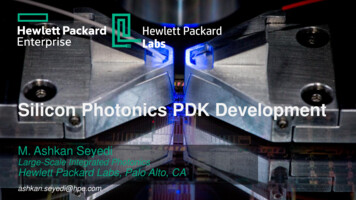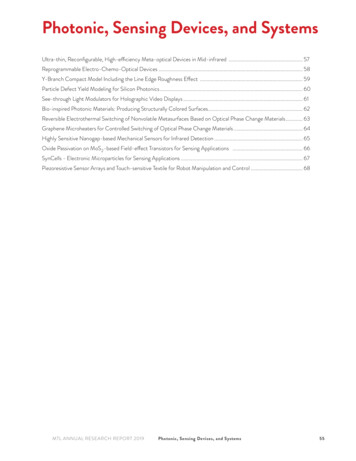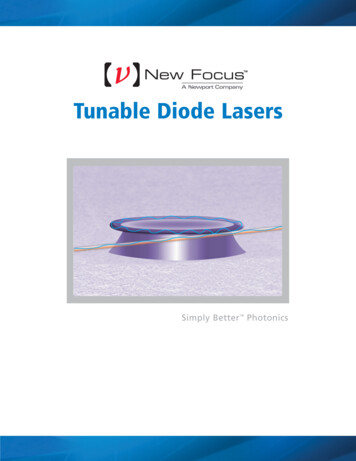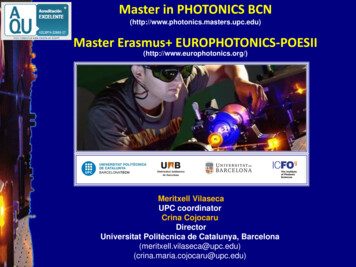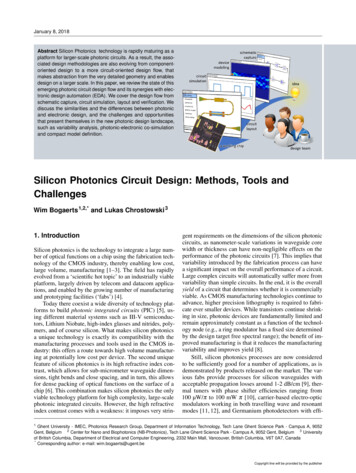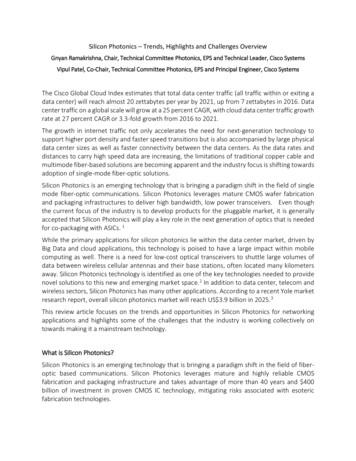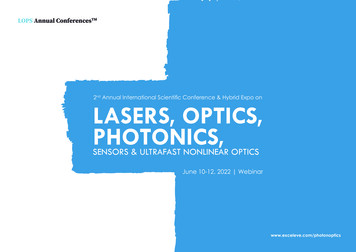
Transcription
2nd Annual International Scientific Conference & Hybrid Expo onLASERS, OPTICS,PHOTONICS,SENSORS & ULTRAFAST NONLINEAR OPTICSJune 10-12, 2022 Webinarwww.exceleve.com/photonoptics
2nd Annual International Scientific Conference & Hybrid Expo onCONFERENCE FEEDBACKLASERS, OPTICS, PHOTONICS,SENSORS & ULTRAFAST NONLINEAR OPTICS Page 2June 10-12, 2022 Virtual Conference
2nd Annual International Scientific Conference & Hybrid Expo onLASERS, OPTICS, PHOTONICS, SENSORS& ULTRAFAST NONLINEAR OPTICSJune 10-12, 2022 Virtual age 3
2nd Annual International Scientific Conference & Hybrid Expo onLASERS, OPTICS, PHOTONICS,SENSORS & ULTRAFAST NONLINEAR OPTICSUIN:LOPS2022:6:69 Odd Higher Harmonic Generation and Ultra -Supercontinuum explained frominstantaneous electronic cloud and slower molecular nonlinear Kerr index ofrefraction of materials for intense Femtosecond laser pulsesfundamental theoretical model is presented for odd Higher Harmonic Generation (HHG) and Ultra –Supercontinuum(USC) light generation based on changes to the instantaneous temporal response of index of refraction n(t) fromultrafast Kerr electronic clouds distortion temporal response and from slower molecular motion from average index ofrefraction n(t) index of refraction from nonlinear Kerr index n2 and n4 at extreme intensities 10 14 W/cm2 for 50 fspulses, respectively.Ultra-Supercontinuum broadening for n2 and n4 at extreme intensity can extend from zero DC frequency to X rays . Atmodest intensity the SC spectra at green pump laser will broadened to yield white light generation on Red Stokes side toBlue Anti-Stokes side covering the entire visible and NIR spectra . Since the SPM process is symmetrical, the spectra for aGaussian 50 fs pump laser pulse at frequency ωo can extents to Anti-Stokes side up to 2 ωo and on the Stokes sidecan extent to DC ( zero frequency). The theory HHG and USC is presented and compared with available experimentaldata.Robert R AlfanoDiscoverer, White-light supercontinuumlaserInitiator, Optical Biopsy, SPIE Gold PrizeAwardee, 2019Founding Director, The City College ofNew York, USAPlenary Speaker, Chief PlanningCommittee member LOPSTM AnnualConferencesThis work was done in collaboration with Shah Faisal Mazhar (CCNY) and Lingyan Shi (UCSD ).BiographyAreas of Expertise/Research:In 2019, Robert Alfano received SPIE (Society of Photo-Optical Instrumentation Engineers) Gold Medal Award, the highest honor bestowed by the society. RobertAlfano is an Italian-American experimental physicist. He is a Distinguished Professor of Science and Engineering at the City College and Graduate School of New Yorkof the City University of New York, where he is also the founding Director of the Institute for Ultrafast Spectroscopy and Lasers (1982). He is a pioneer in the fields ofBiomedical Imaging and Spectroscopy, Ultrafast lasers and optics, tunable lasers, semiconductor materials and devices, optical materials, biophysics, nonlinear opticsand photonics; he has also worked extensively in nanotechnology and coherent backscattering. His discovery of the white-light supercontinuum laser is at the rootof optical coherence tomography, which is breaking barriers in ophthalmology, cardiology, and oral cancer detection (see “Better resolution with multibeam OCT,”page 28) among other applications. He initiated the field known now as Optical BiopsyHe recently calculated he has brought in 62 million worth of funding to CUNY during his career, averaging 1.7 million per year. He states that he has accomplishedthis feat by “hitting the pavement”; he developed a habit of aggressively reaching out to funding partners and getting them interested in his work. Alfano has madediscoveries that have furthered biomedical optics, in addition to fields such as optical communications, solid-state physics, and metrology. Alfano has an outstandingtrack record for achievements regarding the development of biomedical instruments. His contributions to photonics are documented in more than 700 researcharticles, 102 patents, several edited volumes and conference proceedings, and well over 10,000 citations. He holds 45 patents and published over 230 articles inthe biomedical optics area alone. His discovery of the white-light supercontinuum laser is at the root of optical coherence tomography, which is breaking barriersin ophthalmology, cardiology, and oral cancer detection (see “Better resolution with multibeam OCT,” page 28) among other applications. Alfano has trained andmentored over 52 PhD candidates and 50 post-doctoral students. For the past ten years, he has trained innumerable high school students in hands on photonics.Page 4Bonding of Tissues with Light Biomedical Optics andDetection of Cancer with Light Spectroscopy Expertise inProperties of Light and Photonics Ultrafast Spectroscopyand Lasers Physics and Electrical EngineeringScience and Engineering Find more information at:https://en.wikipedia.org/wiki/Robert Alfano## Michael S. Feld Biophotonics Award# Charles Hard Townes MedalJune 10-12, 2022 Virtual ConferencePLENARY SPEAKERA
2nd Annual International Scientific Conference & Hybrid Expo onLASERS, OPTICS, PHOTONICS,SENSORS & ULTRAFAST NONLINEAR OPTICSUIN:LOPS2022:6:70 Deep Tissue Optical Tomography: From Clinical Systems to WearableTechnology.BiographyProfessor Hielscher leads the recently established Department of Biomedical Engineering and directs research in his Clinical Biophotonics Laboratory (CBL). The missionof the CBL is to establish optical tomography as a viable biomedical imaging modality and transfer this technology into clinical practice. The goal is to develop apatient-centered approach that addresses all aspect of modern precision medicine in state-of-the art healthcare. To this end Prof. Hielscher’s team is developingcutting- edge imaging hardware and software that provide 3-dimensional distributions of physiologically relevant parameters such as oxygen saturation or totalhemoglobin concentrations and more. This includes the design of wearable devices that allow continuous patient monitoring. The CBL is currently applying thisemerging technology in various clinical and preclinical studies that focus on the diagnosis and monitoring breast cancer, arthritis, peripheral artery disease (PAD), anddiabetic foot syndrome (DFS). Furthermore, techniques are being developed for real-time monitoring of brain activities.Andreas H. HielscherProfessor, Chair & Director,Clinical Biophotonics Laboratory (CBL),New York University, USAPLENARY SPEAKERResearch Interests: Biomedical Imaging, Medical Instrumentation, Biophotonics, Biomedical Optics, Near-Infrared Imaging, Tomography, Image Reconstruction,Medical Imaging Analysis, Wearable Devices, Imaging of: Breast Cancer, Skin Cancer, Prostate Cancer, Rheumatoid Arthritis, Lupus, Peripheral Artery Diseases (PAD),Diabetic foot Syndrome (DFS), Brain, Modeling of Light Transport in Tissue, Equation of Radiative Transfer (ERT).Page 5June 10-12, 2022 Virtual Conference
2nd Annual International Scientific Conference & Hybrid Expo onLASERS, OPTICS, PHOTONICS,SENSORS & ULTRAFAST NONLINEAR OPTICSUIN:LOPS2022:6:71 Ultrafast laser science and technology using semiconductor diode lasers.his presentation will review the underlying physics of ultrafast, high power pulse generation in diode lasers and show howone can ‘engineer’ around the limitations imposed by physics to achieve new levels of performance. Building on theseideas, stabilized optical frequency combs generation is achieved and lay the foundational groundwork for developingchip scale systems for communication signal processing, lidar and imaging.BiographyPeter J. Delfyett received the B.E.(E.E.) degree from The City College of New York in 1981, the M.S. degree in EE from The University of Rochester in 1983, the M. Philand Ph.D. degrees from The Graduate School & University Center of the City University of New York in 1987 and 1988, respectively. His Ph.D. thesis was focused ondeveloping a real time ultrafast spectroscopic probe to study molecular and phonon dynamics in condensed matter using optical phase conjugation techniques.After obtaining the Ph.D. degree, he joined Bell Communication Research as a Member of the Technical Staff, where he concentrated his efforts towards generatingultrafast high power optical pulses from semiconductor diode lasers, for applications in applied photonic networks. Some of his technical accomplishments werethe development of the world’s fastest, most powerful modelocked semiconductor laser diode, the demonstration of an optically distributed clocking network forhigh speed digital switches and supercomputer applications, and the first observation of the optical nonlinearity induced by the cooling of highly excited electronhole pairs in semiconductor optical amplifiers. While at Bellcore, Dr. Delfyett received numerous awards for his technical achievements in these areas, including theBellcore Synergy Award and the Bellcore Award of Appreciation. Dr. Delfyett joined the faculty at the College of Optics & Photonics and the Center for Researchand Education in Optics and Lasers (CREOL) at the University of Central Florida in 1993, and currently holds the positions of University of Central Florida Trustee ChairProfessor of Optics, ECE & Physics. Dr. Delfyett served as the Editor-in-Chief of the IEEE Journal of Selected Topics in Quantum Electronics (2001-2006), and served onthe Board of Directors of the Optical Society of America. He served as an Associate Editor of IEEE Photonics Technology Letters, was Executive Editor of IEEE LEOSNewsletter (1995-2000) and sits on the Presidential Science Advisory Council of thqQe Orlando Science Center. He is a Fellow of the Optical Society of America, Fellowof IEEE/LEOS, was a member of the Board of Governors of IEEE-LEOS (2000-2002), and is also a member of Tau Beta Pi, Eta Kappa Nu, and Sigma Xi, and SPIE. Dr.Delfyett has been awarded the 1992 YMCA New Jersey Black Achievement Award, the 1993 National Black Engineer of the Year Award – Most Promising Engineer,the University Distinguished Research Award ’99, and highlighted in Design News’ “Engineering Achievement Awards”. In addition, Dr. Delfyett has been awarded theNational Science Foundation’s Presidential Faculty Fellow Early Career Award for Scientists and Engineers, which is awarded to the Nation’s top 20 young scientists.Dr. Delfyett has published over 500 articles in refereed journals and conference proceedings, has been awarded 30 United States Patents, and has been highlightedon ‘C-SPAN’, “mainstreekweek.com” and in “Career Encounters”, a PBS Special on technical careers in the optics and photonics field. Dr. Delfyett was awardedthe 1999 University Distinguished Researcher of the Year Award, the 2000 Black Engineer of the Year Award – Outstanding Alumnus Achievement, and the 2000Excellence in Graduate Teaching Award. He was awarded the University of Central Florida’s 2001 Pegasus Professor Award which is the highest honor awarded by theUniversity. He is also a Founding Member in NSF’s Scientists and Engineers in the School Program, which is a program to teach 8th graders about the benefits of science,engineering and technology in society. In 2003, Dr. Delfyett received the Technology Innovation Award from the Orlando Economic Development Commission. Hewas selected as one of the “50 Most Important Blacks in Research Science in 2004” and as a “Science Trailblazer in 2005 and 2006” by Career Communications Groupand Science Spectrum Magazine. Dr. Delfyett has also endeavored to transfer technology to the private sector, and helped to found “Raydiance, Inc.” which is aspin-off company developing high power, ultrafast laser systems, based on Dr. Delfyett’s research, for applications in medicine, defense, material processing, biotechand other key technological markets. Dr. Delfyett was also elected to serve 2 terms as President of the National Society of Black Physicists (2008-2012). Most recently,he was awarded the APS Edward Bouchet Award for his significant scientific contributions in the area of ultrafast optical device physics and semiconductor diodebased ultrafast lasers, and for his exemplary and continuing efforts in the career development of underrepresented minorities in science and engineering. Awards &Honors International Society for Optics and Photonics (SPIE) Fellow American Physical Society (APS) Fellow IEEE Photonics Society Fellow Optical Society of America(OSA) Fellow 2019 Excellence in Graduate Teaching College Award 2014 Florida Academy of Science’s 2014 Medalist 2013 National Academy of Inventors FellowPage 6Peter J. DelfyettPegasus Professor, Optics & Photonics,ECE & Physics,Director, Townes Laser Institute,University of Central Florida, USALOPS 2021, lops2022TM2013 Letter of Appreciation – SPIE 2013 Faculty Excellencefor Mentoring Doctoral Students 2013 College ResearchIncentive Award (RIA) 2012 Faculty Excellence inMentoring Doctoral Students 2012 College Excellence inGraduate Teaching Award 2012 Excellence in GraduateTeaching Award 2011 Excellence in Graduate TeachingAward 2011 APS Edward Bouchet Award 2010 AmericanPhysical Society Edward Bouchet Award 2010 IEEEPhotonic Society Graduate Student Fellowship 2010SPIE Educational Scholarship in Optical Science andEngineering 2010 Incubic/Milton Chang Travel Awardto attend CLEO 2006 Science Spectrum Trailblazer 2005District Advocate for the American Physical Society2005 Science Spectrum Outstanding Black Professionalin Science 2003 Technology Innovation Award 2003 UCFMillionaire’s Club 2002 Pegasus Professor Award 2002UCF Distinguished Research Professor Award 2002 UCFMillionaire’s Club 2001 UCF Nguzo Saba Award 2000Research Incentive Award (RIA) Research GroupConducting research on ultrafast high power opticalpulses from semiconductor diode lasers, for applicationsin applied photonic networks and laser induced materialsmodification.June 10-12, 2022 Virtual ConferencePLENARY SPEAKERT
2nd Annual International Scientific Conference & Hybrid Expo onLASERS, OPTICS, PHOTONICS,SENSORS & ULTRAFAST NONLINEAR OPTICSUIN:LOPS2022:6:72 Structured Light and Dark by MetaopticsMetasurfaces also offer fresh opportunities for structuring light as well as dark. I will discuss spin to total orbital angularmomentum (OAM) converters and high OAM lasing, as well as flat devices that enable light’s spin and OAM toevolve, simultaneously, from one state to another along the propagation direction . Finally, the demonstration of 2D phaseand polarization singularities and the unique applications that they will open will be discussed.BiographyPLENARY SPEAKERFederico Capasso received the doctor of Physics degree, summa cum laude, from the University of Rome, Italy, in 1973 and after doing research in fiber optics atFondazione Bordoni in Rome, joined Bell Labs in 1976. In 1984, he was made a Distinguished Member of Technical Staff and in 1997 a Bell Labs Fellow. In addition to hisresearch activity Capasso has held several management positions at Bell Labs including Head of the Quantum Phenomena and Device Research Department andthe Semiconductor Physics Research Department (1987–2000) and Vice President of Physical Research (2000–2002). He joined Harvard on January 1, 2003.Federico CapassoJohn A. Paulson School of Engineeringand Applied SciencesHarvard University, Cambridge, MA02138capasso@seas.harvard.eduPage 7June 10-12, 2022 Virtual Conference
2nd Annual International Scientific Conference & Hybrid Expo onLASERS, OPTICS, PHOTONICS,SENSORS & ULTRAFAST NONLINEAR OPTICSUIN:LOPS2022:6:73 Femtosecond Laser Ablation for Chemical Sensors and Other Devicesemtosecond laser ablation is a highly flexible and versatile approach for microfabrication and patterning of differentmaterials useful in chemical and biosensors. Ultrashort laser pulses generate surface energy absorption with reducedsub-surface damage due to the short thermal penetration depth with ultra short pulse duration. A wide range of materialscan be processed with ultrashort laser processing including metals, ceramics, semiconductors and superconductors.Hydrogen sulfide, nitrogen dioxide, and sulfur dioxide are highly toxic gases with health effects at ppb and ppm levels inair. These compounds occur in industrial operations as well as in environmental atmospheric polluted air. Amperometicgas sensors were fabricated on a porous hydrophobic substrate made of layers of a Teflon woven mesh, on to whicha 400 nm gold film was sputtered with a tungsten adhesion layer. A total of 60 sensors was patterned in a 6 by 10 gridper substrate with each sensor having a footprint of 15 mm x 15 mm. Traditionally, microfabricated electrochemical gassensors use photolithography processes for patterning of the electrodes and defining the electrode geometry for highsurface area to increase the sensor gas sensitivity. We present herein a series of gas sensor designs fabricated via laserablation of sputtered Au films. For these sensors, the laser ablation step itself takes less than two hours to pattern up to 60sensors. The sensor electrodes were assembled by lamination between several plastic layers and then an electrolyte wasadded. The assembled sensors were diced from the assembled 10x6 sensor wafer and individual sensors were connectedto a potentiostat and tested via exposure to the various pollutant gases. The current response of these amperometricsensors was measured and found to be linear with respect to concentration in the low ppm range. This work illustrates analternative to photolithography for the preparation of thin film gas porous electrodes for use in amperometric gas sensors.Peter J. Hesketh,D. Struk, Seung Joon PaikSchool of Mechanical Engineering,Georgia Institute of TechnologyV. Patel, D. Peaslee, M. Findlay, J. R.Stetter**KWJ Engineering, Newark, CA 94560BiographyPeter Hesketh received a B.Sc. in Electrical and Electronic Engineering from the University of Leeds (1979) and was a Thouron Fellow at the University of Pennsylvania,obtaining an M.S. (1983) Ph.D. (1987) in Electrical Engineering. He worked in the Microsensor Group at the Physical Electronics Laboratory of Stanford Research Instituteand then Teknekron Sensor Development Corporation before joining the faculty at the University of Illinois in 1990 in the Department of Electrical Engineering andComputer Science. He is a Professor of Mechanical Engineering at Georgia Institute of Technology, Member of the Parker H. Petit Institute for Bioengineering andBiosciences, and Member of the Institute for Electronics and Nanotechnology, in the School of Mechanical Engineering. He is a past chair of the Sensor Division, andpast chair of the Honors and Awards Committee of the ECS. His research interests include micro/nanofabrication techniques, MEMS based chemical gas sensorsand gas chromatography systems, micro-magnetic actuators and microfluidics for sample preconcentration of microbial contamination. He has published over 100journal papers and edited sixteen books on microsystems. He is a Fellow of the AAAS, ASME, ECS, a member of Sigma Xi and IEEE. His is married to Ann Marie withtwo children Gabriel and Lillian Hesketh.Page 8June 10-12, 2022 Virtual ConferenceKEYNOTE SPEAKERF
UIN:LOPS2022:6:1052nd Annual International Scientific Conference & Hybrid Expo on LASERS, OPTICS, PHOTONICS,SENSORS & ULTRAFAST NONLINEAR OPTICSVibrational Spectroscopic Imaging of Biopolymers: From Micrometer toNanometer Scalehis presentation focuses on structural investigations of phase-separated biopolymer blends by vibrational spectroscopicimaging techniques and will illustrate the improvement of lateral resolution from the micro- down to the nanometerscale over the last two decades. Generally, bio-degradable polymers which are produced from raw materials of theagricultural production chain or by the action of microorganisms are rapidly gaining economic importance. This isdue to the increasing demand for reducing the exploitation of fossil raw materials and recycling short-lived productssuch as food packaging and has gained dramatic importance in view of the environmental problem of micro-plastics.Notwithstanding their ecological advantages, such biopolymers must fulfill the same end-user requirements in terms oftheir thermal and mechanical properties as the standard plastics, which presently dominate the world market. However,individual biopolymers do not fulfill these specifications and are blended with other biopolymers for the optimization of theirproperties. Dependent on the blend concentrations, such biopolymer mixtures can undergo phase-separation, which isthe target structural parameter of the reported investigations.In this context, polymer blends of bio-degradable poly(3-hydroxybutyrate) (PHB) and poly(L-lactic acid) (PLA)1 wereanalyzed by FT-IR, Raman and photothermal Atomic Force Microscopy (AFM)-IR imaging spectroscopy. Generally,vibrational spectroscopic imaging enables a detailed lateral and chemical visualization of the investigated samples.However, while the FT-IR and Raman spectroscopic imaging techniques2 are diffraction-limited and have lateral resolutionsof – at best – a few micrometers and a half micrometer, respectively, the advent of the AFM-IR3 technique, that exploitsthe photothermal effect, launched spectroscopic imaging to the 10 nm lateral resolution level with the additional benefitof topographical information. The imaging results obtained from the above biopolymer blends will demonstrate thesignificant improvement of structural details revealed by the application of these techniques ranging from lower to higherlateral resolution (viz. FT-IR, Raman and photothermal AFM-IR spectroscopic imaging).Keywords: FT-IR, Raman, AFM-IR, Imaging Spectroscopy, Biopolymer Blends, Phase-Separation, Lateral Resolution,Micrometer to Nanometer.References:1.T. Furukawa, H. Sato, R. Murakami, J. Zhang, Y-X. Duan, I. Noda, S. Ochiai, Y. Ozaki, Macromolecules, 38 (2005) 6445.2.R. Salzer, H. W. Siesler (eds.); Infrared and Raman Spectroscopic Imaging, WILEY-VCH, Weinheim, Germany (2014).3.J. Mathurin, A. Deniset-Besseau, D. Bazin, E. Dartois, M. Wagner, A. Dazzi, J. Appl. Phys. 131, 010901 (2022).Page 9Miriam Unger1 and Heinz W.Siesler2Bruker Nano Surfaces & Metrology,D 76187 Karlsruhe, Germany; miriam.unger@bruker.com2Dept.of Physical Chemistry, UniversityDuisburg-Essen, D 45117 Essen,Germany; hw.siesler@uni-due.de1BiographyHeinz Wilhelm Siesler is a Professor of Physical Chemistryat the University of Duisburg-Essen, Germany, withexpertise in vibrational spectroscopy in combination withchemometric data evaluation for chemical research,analysis and process control. He has 240 publications(4 monographs) and presented more than 300 lecturesworldwide. Since 2012 he is a Fellow of the Society forApplied Spectroscopy and received several awards(1994 EAS NIR Award, 2000 Tomas Hirschfeld PITTCON NIRAward, and 2003 Buechi NIR Award). Prior to his academicposition he gained industrial experience as sectionhead in molecular spectroscopy and thermal analysisin the R&D Department of Bayer AG, Germany. He alsoworked as lecturer (University of the Witwatersrand,Johannesburg, South Africa) and Post-Doc (University ofCologne, Germany), after receiving his PhD in Chemistry(University of Vienna, Austria). The test and applicationof miniaturized handheld vibrational spectrometers is aspecial research focus over the last ten years.June 10-12, 2022 Virtual ConferenceKEYNOTE SPEAKERT
2nd Annual International Scientific Conference & Hybrid Expo onLASERS, OPTICS, PHOTONICS,SENSORS & ULTRAFAST NONLINEAR OPTICSUIN:LOPS2022:6:80 The Early Days of Self-Phase Modulation, Pulse Compression andSupercontinuum.his presentation attempts to show others the excitement and intellectual growth that occurred during the first ten yearssince the invention of the trivalent Nd-doped mode-locked glass laser. The time period started with total uncertainty asto the nature of the excessive bandwidth of the 5 picosecond pulses, and with my personal frustration for the usefulnessof such pulses. Great progress was made when E. Brian Treacy invented the grating pair whose anomalous dispersioncould compress pulses if they were predominantly positively chirped. This led a lot of us at the time to become moreserious about the possibility that these pulses have an excessive bandwidth associated with an instantaneous frequencywhich could vary with time during the 5 picosecond pulse. In musical terms, although the pulses could be monophonic,homophonic, or polyphonic, the Treacy experiments emphasized the monophonic possibility. This thinking led me, withKelley and Gustafson to invent, publish, and patent a pulse compression scheme where Kerr-like effects can put a chirponto a transform-limited ultrashort (in those days 5 picosecond duration) pulse for subsequent compression by a properlyadjusted Treacy grating pair. A 50 femtosecond compressed pulse was theoretically demonstrated. At about the sametime, I pointed out to Treacy that I thought he had a typographical error in his publication, and he indicated in a correctionto his manuscript that it was really a more fundamental error. I rather quickly found a whole class of pulses which, althoughnot predominantly positively chirped, theoretically produced an excellent fit to Treacy’s auto- and cross- correlation data.By this counterexample, Fleck and I published that Treacy, in today’s language, mistook the “coherent artifact” for thepulse duration. This presentation continues with a discussion of the split-step technique, and our theoretical finding ofextra linear chirping and of shock formation. It took about a quarter of a century for the technology to advance whereour predicted shock formation could be experimentally demonstrated. Finally, attention is drawn to Alfano’s pioneeringSupercontinuum activities.Robert FisherPresident and Senior Laser Physicist, RAFisher Associates, LLC, Santa Fe, NewMexico, USAon SPIE’s Scholarship Committee, and now serves on SPIE’sEducation Committee. Dr. Fisher is a Fellow of the OpticalSociety of America, a Senior Member of the IEEE, and afellow of SPIE. For those needing further information, hisbiography appears in Who’s Who in America.BiographyDr. Robert A. Fisher is President and Senior Laser Physicist with R A Fisher Associates. Dr. Fisher received his Ph.D., M.A., and B.S. degrees from the University of California,Berkeley. Starting in 1971, he worked in the Laser Fusion Group at Lawrence Livermore National Laboratory and he taught graduate courses in nonlinear opticsand solid state physics at the University of California, Davis. Joining Los Alamos National Laboratory in 1974, he was affiliated with the laser fusion and laser isotopeseparation programs. He was a member of seven Red-Blue government panels, and he teaches numerous professional advancement courses. His expertise includes:nonlinear optics, laser technology, carbon dioxide lasers, molecular spectroscopy, x-ray lasers, optical phase conjugation, and modern optics. He has authored over60 publications. He is the Editor of the book “Optical Phase Conjugation,” and he chaired six SPIE Conferences on Nonlinear Optics. He was Associate Editor for thejournal “Applied Optics,” and for the journal “Optics Letters.” He served on the committees of four international Conferences. For the Journal of the Optical Society ofAmerica he was guest Editor of a special issue on Optical Phase Conjugation, and he was a member of the Special Advisory Committee to the Provost, University of NewMexico. He served for three years as a member of the Board of Directors of SPIE, and for three years as Topical Editor of Optics Letters. He serves the legal communityas an Expert Witness. He served on the 2003, 2004 and 2005 Nonlinear Optics Subcommittee for the CLEO Conference, and presently serves as the Chairman of thatSubcommittee. He served on the OSA’s Excellence in engineering award Committee for 2002 and 2003, and as Chair of that Committee in 2004. He served 2002-2004Page 10June 10-12, 2022 Virtual ConferenceKEYNOTE SPEAKERT
2nd Annual International Scientific Conference & Hybrid Expo onLASERS, OPTICS, PHOTONICS,SENSORS & ULTRAFAST NONLINEAR OPTICSUIN:LOPS2022:6:74 Exploring the sub-diffuse scatter of photons by superficial tissue layers usingpolarized light.he superficial layers of a tissue include the epithelial/connective tissue interface where cancer often arises and otherdisease states occur. In skin, the epidermis/papillary dermis interface is modulated by ageing, actinic damage, edema,and cosmetic rejuvenation treatments. While most ( 90%) of observable optical reflectance from a tissue is due to photonsthat have migrated deeply and returned to the surface for escape, a small amount ( 10%) is due to “sub-diffuse” photonsthat have scattered only a few times before escaping. Consequently, sub-diffuse photons offer information about thelight-scattering structures in a superficial tissue layer. Polarized light imaging (PLI) based on the difference image, Q co-polarized - cross-polarized, also involves only a few scattering events. The use of PLI to characterize the scatteringstructures of a superficial tissue is presented.BiographySteven L. Jacques, Ph.D., received a B.S. degree in Biology at M.I.T., and an M.S. degree in Electrical Engineering and Computer Science and a Ph.D. degree inBiophysics and Medical Physics from the University of California-Berkeley (1984), where he used dielectric microwave measurements to explore the in vivo distributionof water in the stratum corneum of human skin. His postdoctoral work was at the Wellman Center for Photo Me
of the City University of New York, where he is also the founding Director of the Institute for Ultrafast Spectroscopy and Lasers (1982). He is a pioneer in the fields of Biomedical Imaging and Spectroscopy, Ultrafast lasers and optics, tunable lasers, semiconductor materials and devices, optical materials, biophysics, nonlinear optics
